2008-07-02 (Flight #2017) |
Flight Photo Album |
Aircraft Flight SummaryDate: 2008-07-02 |
Flight Track Map
Larger image (new window) Download KMZ/KML File (right click, save as) |
Satellite Image from MODIS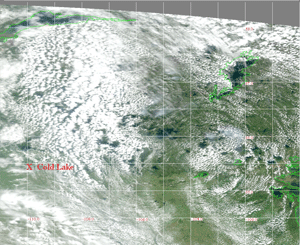
MODIS/Terra larger image (morning) (new window) MODIS/Aqua larger image (afternoon) (new window) |
Satellite Images from GOES-11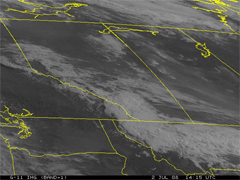 1415 - 2246 UTC |
CAR - (QuickLook)
Imagery from CAR Instrument
Click browse image thumbnail to load more detailed version (images open in a new window)
| Flight Direction | Flight Direction |
|
|
|

|

|
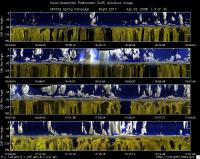
|
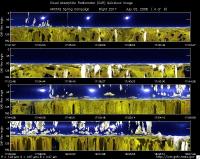
|
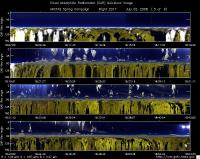
|
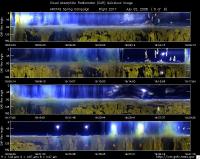
|
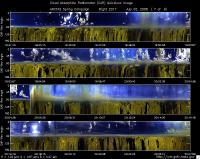
|

|
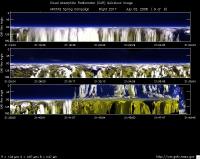
|
Flight Mission Details
Overview:
This was the fourth flight out of Cold Lake, Canada. Science goals include: 1) a coordinated flight segment with the NASA B200 (carrying HSRL and RSP instruments) under the Terra satellite, 2) stacked radiation legs, 3) in situ observations of flaming fires and plume evolution, and 4) vertical profiles of plumes in homogenous fire outflow regions.
P-3B instrument payload:
AATS: Ames Airborne Tracking Sunphotomter (AATS. worked well.
AERO3X: Partially successful.Main AERO-3X instrument absent. Good data for relative humidity system.
BBR: No problems reported.
CAR - Cloud Absorption Radiometer measured angular distribution of scattered radiation and acquired imagery of cloud, smoke, and surface. Filter wheel channel had initial stability problems.
CCN Counter - Continuous-Flow Streamwise Thermal Gradient Cloud Condensation Nuclei (CCN) Counter (CFSTGC) -No problems reported.
COBALT - Carbon monOxide By Attenuated Laser Transmission (COBALT), an autonomous instrument based on off-axis integrated cavity output spectroscopy. Collected good data. Inlet problem solved.
HiGEAR - Hawii Group for Environmental Aerosol Research (HiGEAR) suite of instrument. Excellent flight.
PDS Project Data System (PDS) measured base meteorological and navigational measurements. Fully operational.
REVEAL - The Research Environment for Vehicle-Embedded Analysis on Linux (REVEAL) system is a prototype next-generation tool for aerospace vehicle sensor webs and the future Earth Observation System. Operational the whole flight.
SSFR -Solar Spectral Flux Radiometer. Reported good data.
Summary (Colleen Kelly, 2 July 2008):
Another partially successful flight: Flight objectives included a coordinated flight segment with the NASA B-200 (carrying an HSRL and the RSP instrument) under the Terra satellite, several sets of stacked radiation legs, and in situ observations of flaming fires, plume evolution and vertical profiles of plumes in homogeneous fire outflow regions.
We rendezvoused with the B-200 at 16:25UT, and carried out the set of P-3 maneuvers for radiation objectives as planned, with the B-200 exactly collocated with the P3 at 28kft for about 50 minutes. The location of these maneuvers had to be adjusted in response to plume location and cloud conditions found during flight. The objective to do these measurements within the MISR field of view was abandoned due to lack of fires within the MISR swath. Guided by scientists on the ground, we broke off from the original flight plan to observe fires that were more active and under less cloudy conditions than the previously targeted fire hot spots. We were affected by thin Ci and broken Cu at the more active fires as well. We penetrated the most active fire plume near Reindeer Lake (55.8N/105.2W) at three different altitudes and performed along-plume axis legs for about 50 miles at the same altitudes to study the evolution of aerosol microphysics during down-wind transport. In addition we carried out a vertical profile in the most homogeneous part of the plume and an across-plume low-level leg for radiations purposes (low-level mid-visible AOD of up to 2). We proceeded to multiple fires that were selected using the RTMM (Real Time Mission Manager) displayed MODIS fire hot spots. On one occasion, we sampled outflow from a pyro-Cumulus cloud and penetrated the cloud itself for microphysical observations. Radiation objectives after the intensive in situ observations were aborted because of the presence of thin Cirrus and broken Cumulus cloud fields. Communication with ground-based scientists, and on the aircraft between Flight Scientist and Flight Deck was excellent.
Flight Path, Timing, and Measurements
Approximate time in UTC ( Local Edmonton/Cold Lake time: -6 hours). Activities during CAR flight 2017 on July 02, 2008 out of Cold Lake, Canada. Observations by CAR operator/PI, Charles Gatebe. Some notes adapted from a report by Jens Redemann, flight scientist.
14:45 -- CAR door opened manually in preparation for take off.
14:59 -- CANS system power on.
15:02 -- CAR power on.
15:19 -- engines on.
15:25 -- taxing.
15:31 -- take off. (Jens reported 15:30).
15:31 -- Rendez-vous with B200 near Reindeer Lake. (Jens Redemann)
15:33 -- CAR in active roll mode. Cryopump power on.
15:36 -- partly cloudy.
15:46 -- thin Ci above. Inversion below 3 km. Cu below plane.
15:53 -- 1.6 µm working fine.
15:56 -- exiting cloud layer. But more clouds below.
16:04 -- 382 nm picking up some noise from the cryocooler.
16:06 -- turned off the cryocooler. Noise still visible in the 382 nm. Cause of noise not known. Will investigate.
16:14 -- smoldering fires. Small Cu.
16:16 -- 2.1 micron on.
16:20 -- in progress descent.
16:26 -- at low level.
16:29 -- B200 above.
16:30 -- 2.1 micron stable.
16:37 -- at low level. Pilot say that the top of the BL is at 6000 msl.
16:41 -- no fire activities. At 524m msl.
16:45 -- scattered Cu.. 1.6 micron selected.
16:52 -- smoke plume.
16:53 -- Cu above as we move out of the smoke plume. 1.6 micron stable.
16:55 -- smoke below clouds. AOD 0.226 at 499 micron.
16:59 -- 488 msl. Cloud above, but broken.
17:03 -- in a well mixed boundary layer. AOD 0.12 at 499 micron.
17:03 -- Jet contrail.
17:10 -- 1.6 micron stable.
17:11 -- AOD 0.07. Alt. 1212m msl.
17:15 -- Radiation legs under B200, some Ci present, scattered Cu as well. Jens Redemann)
17:22 -- Scattered Cu.
17:25 -- spiraling up.
17:31 -- straight and level leg at 2435m msl.
17:33 -- slowed speed to catch up with B200.
17:35 -- AOD 0.03. No Ci visible.
17:43 -- spiraling down.
17:50 -- BRDF under broken clouds.
17:51 -- going up to avoid birds.
17:54 -- straight and level.
17:56 -- AOD 0.16 at 499 nm.
17:57 -- marshland, open water spots.
18:02 -- wet ground.
18:05 -- spiraling up.
18:05 -- breaking off from B200; vectoring to fires and locations with less clouds as advised by scientists on ground. (Jens Redemann)
18:22 -- penetrating smoke and clouds(Cu).
18:26 -- AOD 0.26. Smoke and clouds. Good case for looking cloud/aerosol interaction.
18:36 -- flying low out of smoke - 656m msl.
18:41 -- going up. Ci above.
18:44 -- penetrating Cu. Ci above.
18:49 -- maneuvering along-plume runs near Reindeer Lake. Multiple runs at different altitudes. (Jens Redemann)
18:50 -- approaching smoke plume.
18:57 -- going through Cu. Ci above.
19:03 -- reversing the course back to the fires.
19:10 -- penetrating smoke. Can see clouds through smoke?
19:14 -- out of the smoke plume.
19:18 -- penetrating smoke plume. Not bumpy as expected.
19:19 -- strong spike in IR.
19:32 -- spiraling down.
19:32 -- vertical descent in area of homogenous plume. (Jens Redemann)
19:41 -- level out and leaving smoke plume.
19:49 -- penetrating smoke again, but at low level.
19:54 -- out of clouds.
19:59 -- penetrating another smoke plume at low level 737 m msl.
20:02 -- maneuvering across-plume radiation runs. (Jens Redemann)
20:12 -- low level run in hazy conditions.
20:15 -- smoldering fires.
20:27 -- entering another plume.
20:30 -- in situ sampling of multiple fire plumes of varying size and age en route home. (Jens Redemann)
20:31 -- out of the main plume.
20:32 -- lots of clouds above.
20:36 -- entering a plume.
20:40 -- entering same plume again.
20:44 -- penetrated big active plume.
20:46 -- heading into another fire plume. Lots of clouds in the area.
21:01 -- penetrated another big plume which was very active (bumpy).
21:03 -- going to the top of the plume.
21:04 -- penetrated the "heart" of the plume, outflow region. Not too bumpy as feared, but was very dark inside. CAR was reading "zeros" -- thought the instrument had died.
21:13 -- very low signal in the sky at 1.6 micron.
21:20 -- over cloud top.
21:21 -- noise in the 1.6 micron seem to have gone down. Multilayer cloud below flight level 3208 m msl.
21:29 -- lot of fair weather cumulus. 382 nm looks ok.
21:36 -- 870 nm = 1036 nm signal over clouds.
21:39 -- 1.6 micron unstable.
21:42 -- going through clouds.
21:49 -- CAR parked. CAR power off.
21:51 -- landed. CANS power off. (Jens recorded 21:50).
